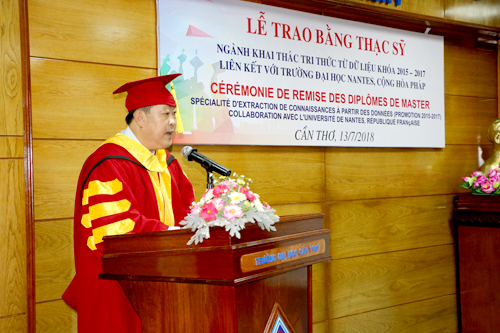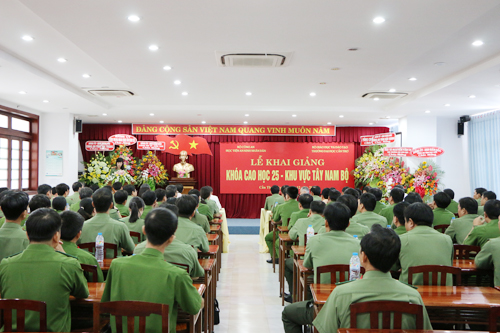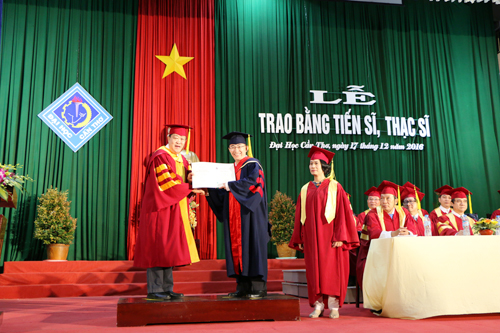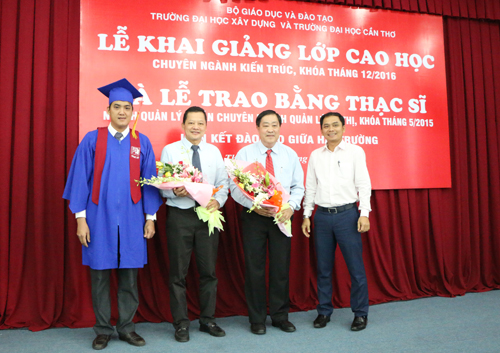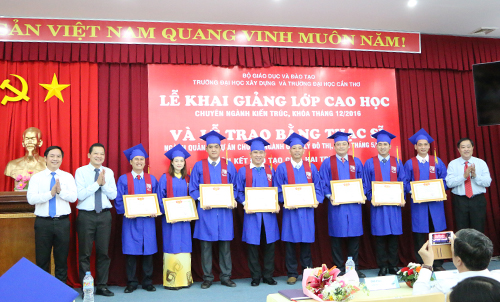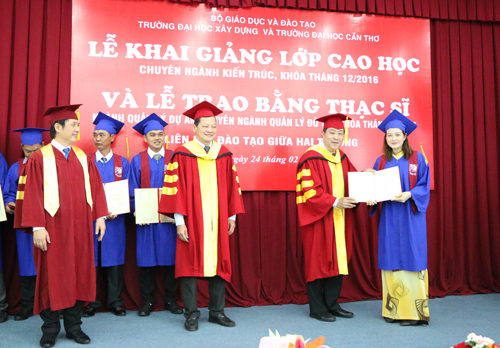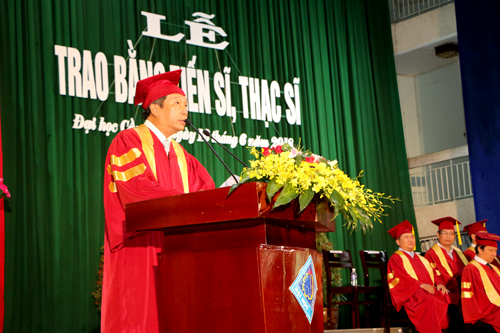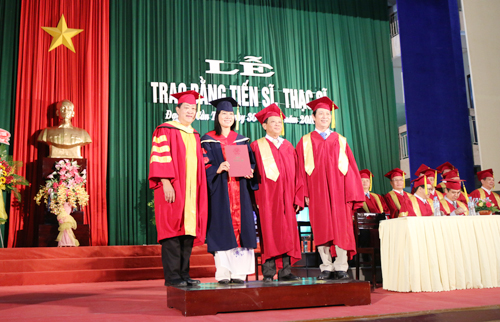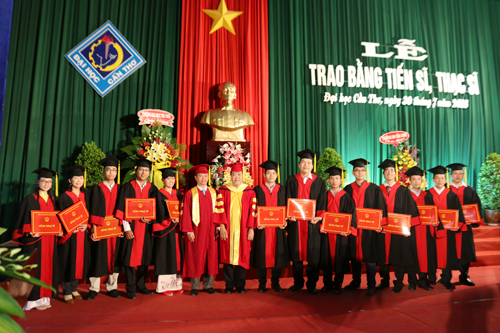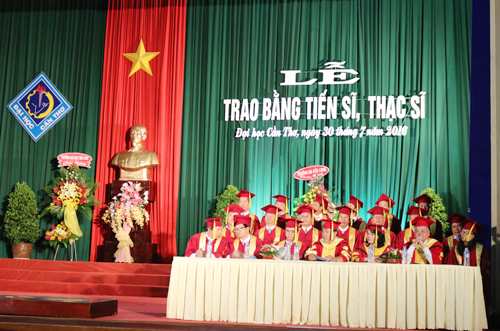
Tên đề tài: “Phân lập và tuyển chọn vi khuẩn kết tụ sinh học, chuyển hóa N và tích lũy Poly-P trong nước thải sản xuất hủ tiếu Mỹ Tho và ứng dụng xử lý nước thải”.
Tác giả: Lê Thị Loan, Khóa: 2016
Chuyên ngành: Vi sinh vật học; Mã số: 62420107. Nhóm ngành: Khoa học sự sống.
Người hướng dẫn chính: GS.TS. Cao Ngọc Điệp - Trường Đại học Cần Thơ.
- Tóm tắt nội dung luận án
Luận án được thực hiện từ tháng 02 năm 2016 đến tháng 8 năm 2018. Kết quả đạt được như sau:
- Phân lập và tuyển chọn các dòng vi khuẩn kết tụ sinh học, loại bỏ N và tích lũy poly-P trong nước thải hủ tiếu.
- Nhận diện và tìm hiểu quan hệ phát sinh của các dòng vi khuẩn kết tụ sinh học, loại bỏ N và tích lũy poly-P trong nước thải hủ tiếu có các đặc tính tốt bằng phương pháp sinh học phân tử và công cụ Tin Sinh học kết hợp với một số mô tả hình thái tế bào và khuẩn lạc đã có. Kết quả nghiên cứu của đề tài là một bộ sưu tập gồm 109 dòng vi khuẩn kết tụ sinh học, chuyển hóa N và tích lũy poly-P. Trong đó: 42 dòng vi khuẩn kết tụ sinh học (23 dòng vi khuẩn có khả năng kết tụ protein và 19 dòng vi khuẩn có khả năng kết tụ polysaccharide), 59 dòng vi khuẩn chuyển hóa N (15 dòng vi khuẩn chuyển hóa ammonium, 18 dòng vi khuẩn chuyến hóa nitrate, 15 dòng vi khuẩn chuyển hóa nitrite và 11 dòng vi khuẩn có khả năng chuyển hóa ammonium, nitrite, nitrate), 8 dòng vi khuẩn có khả năng tích lũy poly-P được phân lập từ nước thải của 8 cơ sở sản xuất hủ tiếu Mỹ Tho, tỉnh Tiền Giang, Việt Nam.
Kết quả cho thấy các dòng vi khuẩn hai nhóm kết tụ sinh học và tích lũy poly-P là đều là họ Bacilaceae trong khi đó vi khuẩn ở nhóm chuyển hóa N có sự đa dạng loài hơn bao gồm vi khuẩn Gram âm và Bacillus trong đó Bacillus chỉ chiếm tới 12% tổng số dòng vi khuẩn.
Do các nguồn vi khuẩn được phân lập có giới hạn trong khu vực nhỏ nên số các thể phân lập không cao và sự đa dạng không nhiều nhưng sự đa dạng vi khuẩn chuyển hóa N rất đáng kể.
- Tuyển chọn một số dòng kết tụ sinh học, loại bỏ N và tích lũy poly-P trong nước thải hủ tiếu tốt nhất để đánh giá hiệu quả xử lý nước thải hủ tiếu trong thùng hay bể chứa có dung tích 100 mL, 1-L, 10-L, 100-L.
- Những kết quả mới của luận án
Kết quả nghiên cứu của luận án là nguồn tài liệu cơ bản, là một bộ sưu tập gồm 109 dòng vi khuẩn kết tụ sinh học, chuyển hóa N và tích lũy poly-P. Trong đó: 42 dòng vi khuẩn kết tụ sinh học (23 dòng vi khuẩn có khả năng kết tụ protein và 19 dòng vi khuẩn có khả năng kết tụ polysaccharide), 59 dòng vi khuẩn chuyển hóa nitơ (15 dòng vi khuẩn chuyển hóa ammonium, 18 dòng vi khuẩn chuyến hóa nitrate, 15 dòng vi khuẩn chuyển hóa nitrite và 11 dòng vi khuẩn có khả năng chuyển hóa ammonium, nitrite, nitrate), 8 dòng vi khuẩn có khả năng tích lũy poly-P.
- Các ứng dụng/khả năng ứng dụng trong thực tiễn, các vấn đề cần tiếp tục nghiên cứu
Tám cơ sở sản xuất hủ tiếu Mỹ Tho – tỉnh Tiền Giang đã thải ra một lượng nước thải khá lớn có pH thấp (chua), chứa nhiều độc chất có hàm lượng cao.
Từ 08 mẫu thu được từ các cơ sở sản xuất hủ tiếu Mỹ Tho – tỉnh Tiền Giang, phân lập 109 dòng vi khuẩn bao gồm 59 dòng vi khuẩn chuyển hoá đạm với 15 dòng vi khuẩn trên môi trường nitrite, 18 dòng vi khuẩn trên môi trường nitrate, 15 dòng vi khuẩn trên môi trường ammonium và 11 dòng vi khuẩn trên môi trường nitơ tổng hợp; 42 dòng vi khuẩn sản xuất chất kết tụ sinh học bao gồm 23 dòng vi khuẩn kết tụ chất protein và 19 dòng vi khuẩn kết tụ chất polysaccharide; 08 dòng vi khuẩn tích luỹ poly-P trên những dòng môi trường chuyên biệt.
Tuyển chọn được dòng vi khuẩn kết tụ sinh học là Bacillus subtilis PRO.01.C và Bacillus subtilis PO.03.B; dòng vi khuẩn chuyển hóa nitơ gồm Bacillus altitudinis HNi.01.03.DL, Stenotrophomonas maltophilia HNa.02.03.C, Enterobacter hormaechei HAm.03.05.C và dòng vi khuẩn tích lũy poly-P Bacillus megaterium Poly-P.06.4.B.để xử lý nước thải hủ tiếu từ 100-mL, 1-L, 10-L, 100-L và 1000-L và kết quả đạt được pH nước thải từ 4,68 lên 6,13, TSS từ 369 mg/L giảm xuống 17 mg/L, BOD5 từ 1200 mg/L giảm xuống 23 mg/L, TKN từ 45 giảm xuống 7,57 mg/l, TP từ 7,57 giảm xuống 4,76 mg/ đạt tiêu chuẩn B, của QCVN40:2011/BTNMT sau 4 ngày sục khí 8/24 giờ.
Cần tiếp tục nghiên cứu: kiểm tra tính an toàn sinh học của các dòng vi khuẩn đã phân lập trước khi đưa vào sử dụng rộng rải.
- THESIS SUMMARY
Thesis was implemented from February 2016 to August 2018. The outcomes gained are as follows:
Isolation and selection of bioflocculant-producing, N removal and poly-P accumulating bacterial strains in wastewater from rice noodle mills.
Identification and investigation are conducted into the generative relationships of bioflocculant-producing, N removal and poly-P accumulation bacteria strains in wastewater from hu tieu with good properties by molecular biology method and informatics-biological tools, associated with several existing cellular morphological and bacterial colony descriptions. The research results of the topic are a collection of 109 bioflocculant-producing bacterial strains, N conversion and poly-P accumulation. Inclusive: 42 strains of bioflocculant bacteria (23 strains of bacteria capable of protein agglutination and 19 strains of bacteria capable of agglutination of polysaccharide), 59 strains of N-converting bacteria (15 strains of ammonium-converting bacteria , 18 strains of nitrate converting bacteria, 15 strains of nitrite converting bacteria and 11 strains of bacteria capable of converting ammonium, nitrite, nitrate), 8 strains of bacteria capable of accumulating poly-P isolated from wastewater from 8 My Tho noodle production mills, Tien Giang province, Vietnam.
The results show that the bacteria strains of the two groups of bioflocculant and poly-P accumulation are all Bacilaceae, while bacteria in the N converting group have more species diversity including Gram-negative bacteria and Bacillus, in which Bacillus only accounts for 12% of the total bacterial strains. Because the isolated bacterial sources are limited in a small area, the number of isolates is not high and the diversity is not much, but the diversity of the N-converting bacteria is very significant. Select a number of bioflocculant strains, N removal and poly-P accumulation in the best noodle effluent to evaluate the efficiency of noodle wastewater treatment in a 100 mL tank or reservoir, 1- L, 10-L, 100-L.
- NEWLY-FOUND OUTCOMES OF THE THESIS
The research results of the thesis are basic documents, a collection of 109 bacterial strains of bioflocculance, N conversion and poly-P accumulation. Included: 42 strains of bioflocculant bacteria (23 strains of bacteria capable of protein bioflocculant generation and 19 strains of bacteria capable of agglutination of polysaccharide), 59 strains of nitrogen converting bacteria (15 strains of bacteria converting ammonium , 18 strains of nitrate converting bacteria, 15 strains of nitrite converting bacteria and 11 strains of bacteria capable of converting ammonium, nitrite, nitrate), 8 strains of bacteria capable of accumulating poly-P.
- APPLICATIONS, RELEVANCE IN PRACTICE, ISSUES OF FURTHER RESEARCH
Eight mills producing My Tho rice noodles - Tien Giang province, have released a sizable amount of wastewater with a low pH (sour), high levels of toxins.
From 08 samples collected from the My Tho noodle production mills - Tien Giang province, 109 strains of bacteria, including 59 strains of nitrogen-converting bacteria with 15 strains of bacteria on nitrite medium, 18 strains on Nitrate medium, 15 strains on ammonium medium and 11 strains on synthetic nitrogen medium; 42 strains of bacteria producing bioflocculants, including 23 strains of protein agglutination bacteria and 19 strains of polysaccharide agglutination bacteria; 08 strains of bacteria accumulate poly-P on specialized media lines. Bacillus subtilis PRO.01.C and Bacillus subtilis PO.03.B are selected for bioflocculant strains; Nitrogen converting bacteria strains include Bacillus altitudinis HNi.01.03.DL, Stenotrophomonas maltophilia HNa.02.03.C, Enterobacter hormoneaechei HAm.03.05.C and poly-P accumulating bacterial strain Bacillus megaterium Poly-P.06.4.B. For treatment of noodle wastewater from 100-mL, 1-L, 10- L, 100-L and 1000-L and the result achieved wastewater indicates wastewater pH from 4.68 to 6.13, TSS from 369 mg / L reduced to 17 mg / L, BOD5 from 1200 mg / L reduced to 23 mg / L, TKN from 45 to reduced 7.57 mg / l, TP from 7.57 to 4.76 mg / meets standard B, of QCVN40 : 2011 / BTNMT after 4 days of 8/24 hour aeration.
Further research is needed: to check the biosafety of isolated bacterial strains before they are widely used.
- Xem chi tiết nội dung luận án
- Xem thông tin đăng tải tại Website Bộ giáo dục và Đào tạo. (Nhập tên NCS vào ô tìm kiếm)





